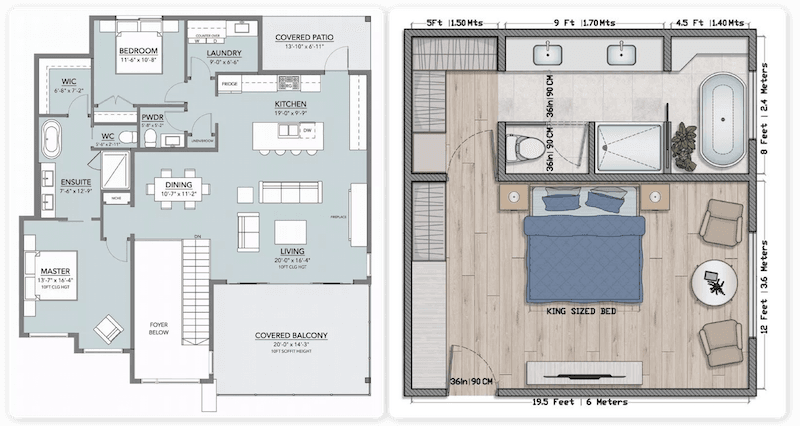Free AI Feng Shui Generator
for Room & Layout Analysis
Upload your room or apartment floor plan to get personalized feng shui analysis powered by AI. Find your lucky layout in seconds.
Get Your Feng Shui Report
You may upload up to three floor plan images.
If they are from different floors, please mark the floor number clearly on each image.
Additional Information
How the AI Feng Shui Generator Works
1. Upload Your Image
Upload a clear floor plan or room layout photo to get the best feng shui analysis. Make sure the image shows the full layout, includes the north direction, and clearly marks each room’s function — this helps the AI feng shui tool provide accurate and personalized suggestions.

2. Add Basic Info
Tell us whether the top of the floor plan points to North, your building type (e.g., apartment or house), and the floor level. This helps the AI feng shui system understand orientation and context, offering more accurate feng shui recommendations based on energy flow and five-element balance.

3. Get Feng Shui Insights
Our AI Feng Shui Generator analyzes your floor plan or room layout to assess energy flow and five-element balance. Instantly get personalized suggestions to improve layout, optimize bagua areas, and create a more harmonious living space.

Use Cases for the AI Feng Shui Generator

Feng Shui Check Before Purchase
Thinking of buying a new apartment or home? Upload the floor plan and get instant feng shui feedback from AI — to avoid bad energy layouts before it's too late.

Optimize Your Current Layout
Already moved in? Let AI analyze your existing floor plan and suggest feng shui improvements — from room positions to energy flow corrections.

Check a Bedroom or Living Room
Upload a floor plan to receive feng shui analysis that helps you arrange your space for better energy flow, emotional well-being, and a more harmonious daily life.
Why Choose AI Feng Shui?
Traditional feng shui analysis can be expensive, time-consuming, and hard to understand without years of study. Our AI-powered tool makes it fast, visual, and accessible to everyone.

AI Image Understanding
Just upload a floor plan or room image—our AI can understand layout, lighting, and furniture to generate accurate feng shui insights.
No Consultant Needed
Skip the hassle of hiring a feng shui master or reading piles of complicated books. Our tool is free to use and gives you feng shui suggestions.
Spot Issues Early
Quickly identify potential feng shui problems before you move in or decorate. Avoid bad placements and design with energy in mind.
Frequently Asked Questions
What is feng shui?
Feng shui is an ancient Chinese practice of spatial harmony.
The term “feng shui” translates to “wind and water” in Chinese. It is a traditional philosophy that focuses on arranging your living environment—especially floor plans, furniture, and room layout—to create balance and enhance positive energy flow, or chi (气).
In feng shui, how you position elements like doors, beds, and windows can affect your well-being, relationships, career, and prosperity. Proper feng shui brings harmony, stability, and good fortune into your life.
- Chi (energy) should flow smoothly throughout a space.
- The five elements (wood, fire, earth, metal, water) must be balanced.
- The bagua map links parts of your home to areas of life like health, wealth, and love.
Modern AI feng shui tools, like this one, help apply these timeless principles to your room or layout by analyzing spatial arrangements, directions, and balance in seconds.
Can AI help with feng shui?
Yes — AI is now powerful enough to interpret floor plans and room layouts for feng shui purposes. By using computer vision and trained feng shui models, AI can identify key layout features and provide practical suggestions based on energy flow, the five elements, and bagua zones.
- Detects layout features: walls, doors, beds, desks, and directions
- Applies traditional feng shui rules like chi flow and command position
- Provides instant analysis — no need for a feng shui master
- Suggests how to improve layout, element balance, and furniture placement
In short, AI brings modern speed and convenience to ancient feng shui wisdom — and tools like this one let you get free, personalized advice in seconds.
What can I upload for AI Feng Shui analysis?
Currently, the AI Feng Shui tool supports only two types of image uploads: floor plans or room layout sketches. It does not support photo-based analysis for furniture placement (e.g., desktop feng shui or bedside photos) — although this feature may be considered in the future.
For accurate results, please follow the traditional “North on top” (上北下南) orientation when drawing or uploading a floor plan. If your floor plan uses a different orientation, be sure to mark the North direction clearly with an arrow or compass symbol. This helps the AI correctly identify directions like southeast or northwest, which are essential for feng shui analysis.
Make sure your floor plan is clear and legible. Use readable labels for each room or area (e.g., “Living Room,” “Bedroom”) and ensure symbols for beds, tables, or appliances are as precise as possible. This prevents misinterpretation during AI recognition.
How can I improve the accuracy of the AI Feng Shui analysis?
To get the most reliable feng shui analysis from our AI tool, make sure each uploaded image contains only one floor plan or layout. Please do not combine multiple floor plans into a single image — this may confuse the AI and reduce accuracy.
The image should be clear, sharp, and well-labeled. Use easily readable room names (e.g., "Kitchen", "Master Bedroom") and avoid blurry handwriting or low-resolution scans. Clear icons for beds, desks, or fixtures will help the AI recognize key features accurately.
You can also use the "Additional Information" section to specify the language you want the analysis to be in — for example, English or Chinese — and include any special notes you'd like the AI to consider.